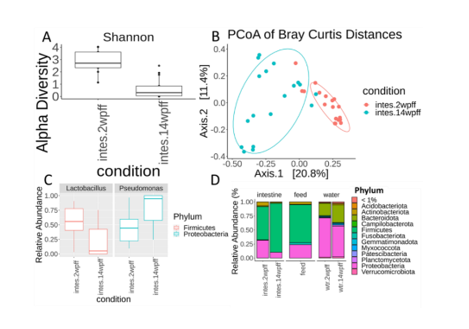GUT MICROBIOTA IN ATLANTIC SALMON Salmo salar AT DIFFERENT DEVELOPMENTAL STAGES
Understanding the interplay between gut microbiota and gut function in farmed fish is important for designing the aquaculture feeds that maximise fish health and performance from first feeding to commercial size. 16S rRNA V3-V4 amplicon sequencing was utilised to investigate the microbial communities in the gut of Atlantic salmon at two weeks and 14 weeks post-first feeding (wpff). Fish were raised in triplicate tanks and fed marine-rich diet from first feeding to the end of experiment. Intestinal samples were collected at two and 14 wpff from 6 fish per tank (36 samples in total). Water and feed samples were also collected. Sequences were analysed using DADA2 to identify the microbial community as Amplicon Sequence Variants (ASVs). Richness and diversity of gut microbiota significantly decreased across fish development (Chao1 P < 0.05; Shannon P < 0.0001) (Figure 1A). Beta-diversity analysis showed clear separation between fish developmental stages (Figure 1B). The dominant bacterial taxa changed significantly with time (Figure 1C, D). Core microbes were detected at ≥ 0.1% in 80% of the fish at each developmental stage. At two wpff, 14 core ASVs were identified compared to a single ASV (unclassified genus of Family Ruminococcaceae) at 14 wpff. The fish gut microbiota was impacted by the environmental conditions (e.g., Firmicutes from feed and Proteobacteria from water) and potentially by changes in selectivity in the fish during development. These findings are important for understanding the interaction between fish gut and gut microbiota in the developmental context.
The work was funded by BBSRC grant NUTRIPROG (BB/R018812/1) and MT was funded by Newton-Mosharafa PhD Scholarship
